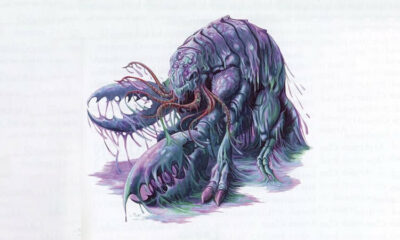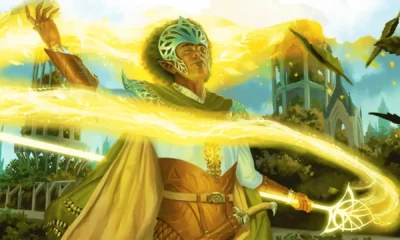Dungeons & Dragons
Grease 5e D&D Guide

Salutations, fellow adventurers! I’m Alex Hawthorne, your guide to the intricate art of spellcasting.
Today, let’s unravel the wonders of the Grease spell, a magical concoction that can tip the scales of any battle.
With its slick properties, Grease can turn even the fiercest foes into stumbling amateurs, all at the flick of a wand.
Join me as we explore the depths of this spell, its rules, and clever ways to wield its slippery power.
What is Grease in D&D 5e?
Grease is a 1st-level conjuration spell that lets me conjure a slick substance onto a surface.
When cast, this slippery grease makes it difficult for creatures to keep their footing, causing them to fall prone if they fail to navigate the greasy terrain.

How to Use Grease:
Mastering Grease requires finesse and strategy.
Here’s how I can effectively utilize this spell:
- Casting Grease: With a swift incantation and a gesture, I can cast Grease on a 10-foot square area within range. Any creature entering or starting its turn in the area must succeed on a Dexterity saving throw or fall prone.
- Strategic Placement: I strategically cast Grease on surfaces where enemies are likely to tread, creating obstacles that impede their movement. Doorways, narrow hallways, and bridges are excellent locations for casting Grease, making it challenging for enemies to approach or escape.
- Impeding Pursuers: When fleeing from pursuers, I can cast Grease on the ground behind me. My pursuers will find it difficult to chase me, giving me precious moments to distance myself from danger.
- Aiding Allies: Grease isn’t just for hindering enemies. I can cast it strategically to aid my allies, making it difficult for foes to approach them. This way, my comrades can maintain a safer distance while still delivering devastating attacks.
- Combining with Fire: Grease is flammable. By coordinating with a fire-wielding ally, we can turn the greased area into a fiery trap, damaging enemies who fail to escape the flames.
Rules for Using Grease:
- Spell Level: Grease is a 1st-level conjuration spell, which means you need to be at least a 1st-level spellcaster (such as a 1st-level wizard) to cast it.
- Casting Time: Grease has a casting time of 1 action. This means it takes your character one full action to cast the spell.
- Range: The spell has a range of 60 feet. This means you can cast Grease on a point within 60 feet of you.
- Area of Effect: Grease affects a 10-foot square area centered on a point within range. Creatures entering or starting their turn in this area must make a Dexterity saving throw or fall prone.
- Saving Throw: The Dexterity saving throw DC (Difficulty Class) to resist the effects of Grease is determined by your spellcasting ability. The formula for the DC is 8 + your proficiency bonus + your Intelligence modifier (for wizards). If a creature succeeds on the saving throw, it avoids falling prone.
- Duration: Grease’s duration is 1 minute, which means the greased area persists for 1 minute after the spell is cast. Creatures entering the area or starting their turn there during this time are subjected to the effects of the spell.
- Difficult Terrain: The greased area becomes difficult terrain for the duration of the spell. This means that it costs 2 feet of movement for every 1 foot a creature moves within the greased area.
- Flammability: Grease is flammable. A creature standing in the greased area when it is ignited (by a torch or a fire spell, for example) takes 2d4 fire damage at the start of its turn. A creature that enters the area or ends its turn there must also succeed on a Dexterity saving throw or fall prone.
- No Concentration Required: Grease does not require concentration, allowing you to maintain concentration on other spells or effects while the greased area hampers your enemies.
Examples of Grease Usage:
Picture this: I find myself cornered in a narrow corridor, a horde of goblins closing in. With a sly grin, I cast Grease right at their feet. The once-confident goblins now struggle to keep their balance, slipping and sliding as they attempt to approach. Seizing the opportunity, I and my allies launch our attacks, taking down the disoriented goblins one by one.
In another scenario, a burly ogre charges toward me, its massive club raised high. Quick on my feet, I cast Grease beneath its feet. The ogre loses its footing, crashing to the ground with a resounding thud. While it struggles to stand, my party and I strike true, exploiting its vulnerable state.
Frequently Asked Questions (FAQs) about Grease in D&D 5e:
Q: Can Grease be cast on walls or vertical surfaces?
A: No, Grease targets a horizontal surface. It cannot be cast on walls or other vertical structures.
Q: Can creatures with a climb speed move through Grease without slipping?
A: Yes, creatures with a climb speed can move through Grease without making a Dexterity saving throw. The spell’s effects specifically target creatures attempting to walk or stand on the greased surface.
Q: Can Grease be ignited by a torch or other open flame?
A: Yes, Grease is flammable. If an open flame, such as a torch, comes into contact with the greased area, it can ignite, creating a fiery effect within the spell’s area.
Q: Can Grease be used underwater?
A: Grease can be used underwater, but its effectiveness might be diminished. Creatures in water typically have advantage on saving throws against spells that create difficult terrain, like Grease.
Q: Can Grease be dispelled by spells like Dispel Magic?
A: Yes, Grease can be dispelled by spells like Dispel Magic, ending its effects prematurely.
With Grease at my fingertips, I can outmaneuver even the most formidable adversaries, turning the battlefield into a playground of slippery chaos.
May your spells be as effective, and your enemies as unsteady, as mine.
Safe travels and may your adventures be filled with clever strategies and victorious outcomes!

-

 Dungeons & Dragons7 months ago
Dungeons & Dragons7 months agoAberrations 5e D&D Guide
-

 Dungeons & Dragons6 months ago
Dungeons & Dragons6 months agoHeavy Crossbow 5e D&D Guide
-

 Dungeons & Dragons6 months ago
Dungeons & Dragons6 months agoUnderstanding Size Categories in Dungeons & Dragons Guide
-

 Dungeons & Dragons6 months ago
Dungeons & Dragons6 months agoMinor Illusion 5E D&D Guide
-

 Dungeons & Dragons7 months ago
Dungeons & Dragons7 months agoHerbalism Kit 5e D&D Guide
-

 Dungeons & Dragons7 months ago
Dungeons & Dragons7 months agoThaumaturgy 5e D&D Guide
-

 Dungeons & Dragons6 months ago
Dungeons & Dragons6 months agoRay of Sickness 5e Dungeons & Dragons Guide
-

 Dungeons & Dragons6 months ago
Dungeons & Dragons6 months agoLight Crossbow 5e D&D Guide
